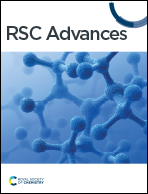Enhanced charge transport properties of an LFP/C/graphite composite as a cathode material for aqueous rechargeable lithium batteries†
Abstract
Electrodes that offer quick ion transport, a large surface area, and excellent electrical conductivity support high performance aqueous rechargeable lithium batteries. LiFePO4 (LFP) nanoparticles have been successfully coated with carbon by a chemical sol–gel route, and assembled on graphite by an ultrasonication method to acquire LFP/C/graphite. This LFP/C/graphite composite exhibits exceptional electrochemical performance at various current densities (1C to 20C). LFP/C/graphite delivers better capacity that is higher than that of LFP/C particles and high stability after 60 cycles at a current density of 1C for aqueous rechargeable lithium batteries as a cathode material. The graphite serves as a good volume buffer in improving the lithium performance of LFP/C/graphite during the charge/discharge process. The LFP/C/graphite composite shows high rate capability at 20C that returned to the initial capacity at 1C after 25 cycles with coulombic efficiency of 97%. Therefore, this effort presents a super low-cost route to fabricate high performance cathode materials in aqueous rechargeable lithium batteries and other energy storage appliances.



 Please wait while we load your content...
Please wait while we load your content...